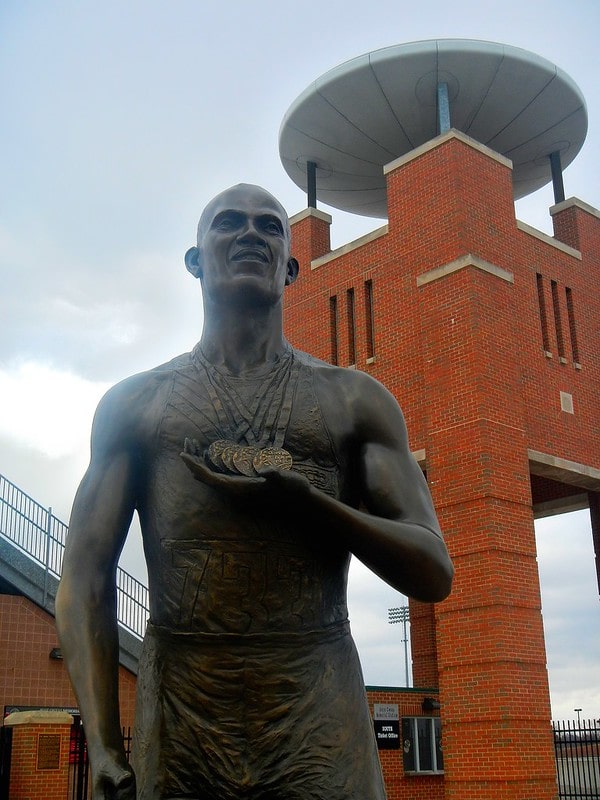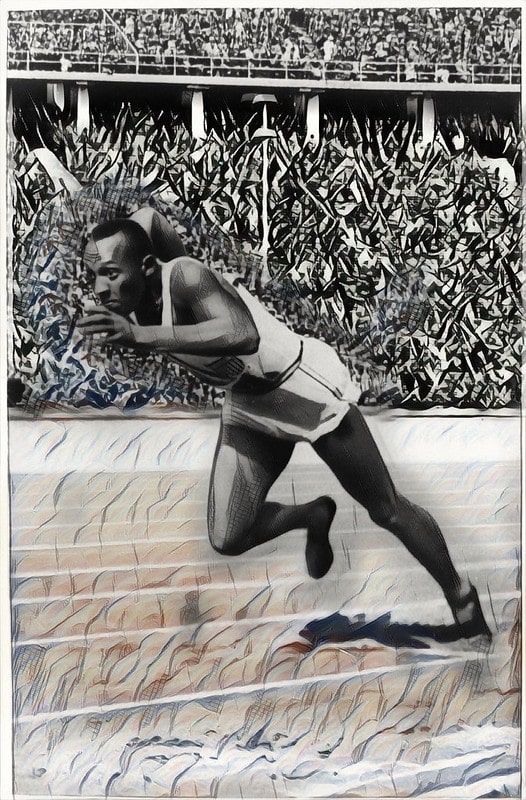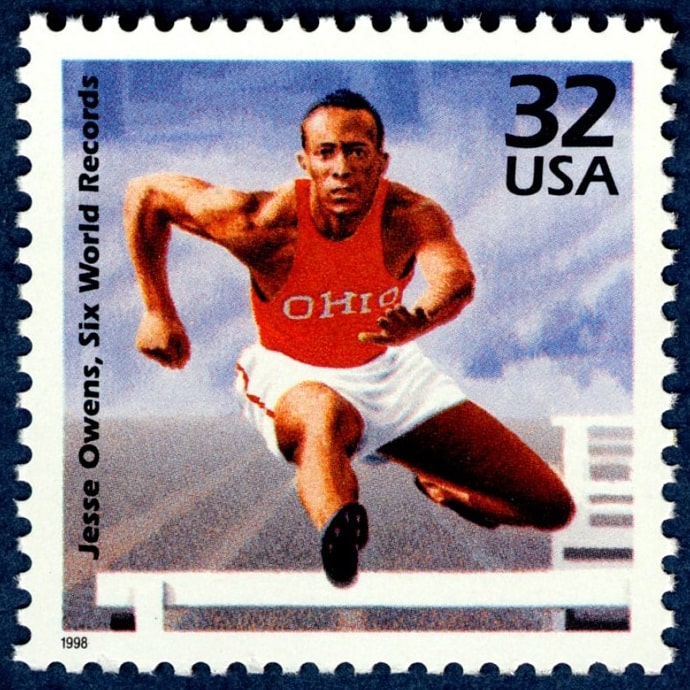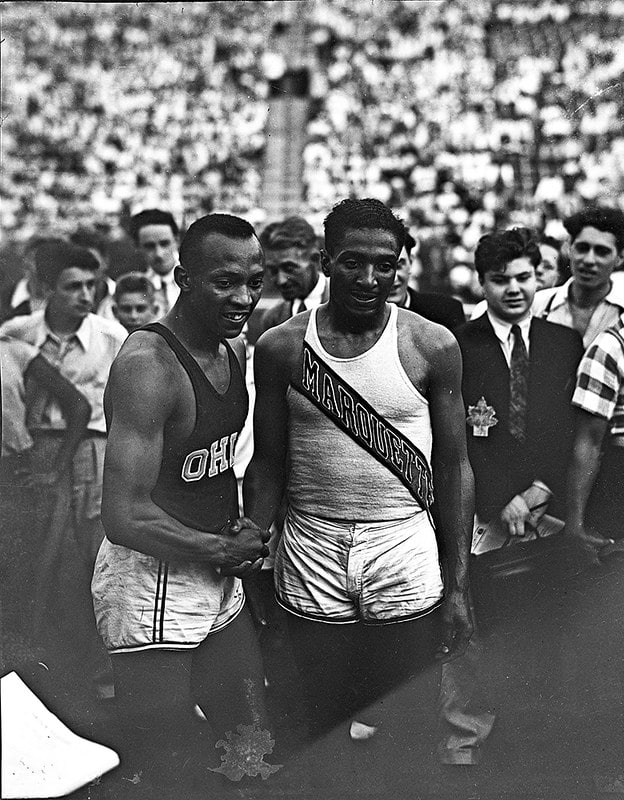Last updated on April 18th, 2022
The aim of this article is to enlighten you about 50 facts about Jesse Owens, perhaps the greatest and most famous athlete in track and field history. Here we cover facts about his childhood, family, athletic achievements, battle with disease and poverty, and much more.
1. Jesse Owens was born on the 12th of September in Oakville, Alabama, U.S.A. According to his statements he was molded more or less by the desperate circumstances and tragic events of his childhood, first in Alabama and then in Ohio.
2. He was the tenth and the last child of Mary Emma and Henry Cleveland Owens. He was essentially happy during his childhood days since he had no inkling about his poverty.
3. His father was a sharecropper whose daily life was full of struggles. If rainfall was not enough or if there was an abundance of it, a crop could fail. It was the same if there was too much frost, forcing him to take all his resources to feed his family.

4. Apart from shelter, food, and the simplest clothes were an unaffordable luxury for his parents, including medical care. It shows the extreme poverty in which Jesse Owens grew up.
5. The day following which he turned five, he noticed a rubbery formation on his chest. This was to be the defining moment of his life. He initially believed that the bump would go away, but it kept on growing and started pressing against his lungs.
6. He notified his mother about it. Unable to bear his discomfort, his mother told Henry that they needed to do something about it. Although his parents resorted to surgery to remove a lump of Jesse’s leg, this one was big and near his heart.
7. Such was the financial condition of the Owens that they could not afford a physician’s service. Jesse’s mother sterilized a kitchen knife over a flame and used it to cut down out the gelatinous lump from his chest.
8. Post-surgery, a hole the size of a golf ball in the operated area started spurting blood. Jesse’s mother tried to stop the bleeding, but it continued for days. Jesse rose from his bed and walked to the front door of his tiny house three days after the operation.

9. Jesse walked into his father’s arms and urged him to pray. Both son and father knelt and prayed. According to Jesse, the bleeding stopped within a few minutes.
10. When he became an adult, Jesse described his youth in Oakville as extremely miserable, which consisted of an endless cycle of humiliation, hunger, and poverty. He never considered himself deprived, despite these factors.
11. Although Jesse along with his three sisters and six brothers had no option apart from spending one week each year picking cotton, all of them were free to play in the fields farmed by Henry.
12. For the Owens family, religion was a constant. They were fervent Baptists and congregants at the Oakville Missionary Baptist Church in which Henry was a deacon.
13. Jesse, along with his brothers and sisters attended the schoolhouse for Oakville’s black kids. However, there was nothing worth learning apart from how to read and write. Jesse spent most of his time running barefoot in the fields, because he loved it.

14. Jesse often used to say that he loved running. He also mentioned that he was not very good at it, as it was something that he could do on his own. He could run in any direction he wanted at the speed he wished.
15. Few people are aware about the fact that Jesse, the famous track and field athlete of the United States who set a world record in the long jump that stood for 25 years, had a byname of James Cleveland Owens.
16. The Owens family shifted to Cleveland in 1922. Following this, Jesse enrolled in the Bolton Elementary School, where he became known as “Jesse.” There is an interesting anecdote regarding this.
17. After moving to Cleveland and on his initial day at Bolton Elementary School at the age of 9, his teacher misunderstood his Alabama drawl and believed his name was Jesse instead of J.C. He was referred to by this name for the rest of his life. He later moved to Fairmount Junior High School.
18. In the year 1928, Jesse sets his first record in the long jump and high jump at the Fairmount Junior High School under the tutelage of Charles Riley, his coach and life-long mentor. Such was the connection between the two, Owens considered Riley as his second father, and Riley held Owens in equal regard. Riley also invited Owens to his home and treated him like a member of his own family. Two years later he enrolled into the East Technical School of Cleveland where he met Minnie Ruth Solomon, his wife to be.
19. Jesse met Minnie when she was 13 years of age and he was 15. They dated steadily throughout high school. Ruth gave birth to Gloria, their first baby daughter on 8 August, 1932.
20. Overall, Jesse and Minnie had three daughters, Gloria, Beverly, and Marlene. When her father competed in the Olympics, Gloria was just four years old. All of his daughters live in Chicago.

21. Jesse attended Ohio State University following a stellar high school career. He was placed on academic probation after taking advantage of the financial opportunities his fame offered, when he returned to Ohio State University after doing so well in the 1946 Summer Games.
22. Following the academic probation enforced on him, he withdrew from Ohio State University in December 1941 and never finished his degree. He remained an undergraduate for the rest of his life.
23. Owens broke three world records in a 45 minute span at the Big Ten Conference in Ann Arbor on 25 May 1935. He broke the 220 yard low hurdles, 220 yard dash, and the long jump. He also tied the 100 yard dash.
24. In college he was a member of the Alpha Phi Alpha fraternity. He was known as the “Buckeye Bullet” in Ohio State. In 1976, President Ford awarded him the Presidential Medal of Freedom.

25. Such was the prowess of Jesse that the United States Postal Service issued two postage stamps in his honor. The first was released in the year 1990 and the second in the year 1998.
26. Jesse Owens was so famous that the Ohio State Department of Athletics added a 10,000 seat track and field stadium in his name. This stadium, considered the finest multi-sport facilities in the country is located on the north of Lane Avenue on Fred Taylor Drive.
27. In 1999 and 2000, the ESPN SportsCentury program created a list on the leading 100 athletes of the twentieth century. Jesse Owens figures sixth in this list under the track and field category.
28. J.C. created history in the 1936 Olympic Games held in Berlin. During this period, Adolf Hitler had gained power via his Nazi party. He won the gold medal for the 4 x 100 meter relay, the 200 meter sprint, the long jump, and the 100 meter sprint.

29. Just after the 1936 Olympics, there was an allegory that Hitler, infuriated by the fact that an African American won four gold medals, refused to congratulate Owens. However, the two exchanged congratulatory waves and Hitler gave J.C. a friendly little Nazi salute.
30. The harsh reality was that Roosevelt, the American president, neither acknowledged the triumphs of Jesse nor invited him to the White House. Jesse said that it was his president, and not Hitler, who snubbed him.
31. Few people are aware that Jesse won shoes crafted by Adidas during his famous stint at the German Olympics. The triumph of the athlete helped German shoemaker, Adolf “Adi” Dassler launch his business. Ten years later, Dassler launched Adidas — his own company.

32. Jesse returned home after the Olympics and had to face a tough time for the next few years. There was a point during this period when he had to file for bankruptcy as well as worked at a gas station to pay his outstanding bills.
33. He also started participating in stunt races against motorcycles, dogs, as well as horses between doubleheaders of the Negro League baseball games and during halftime of soccer matches.
34. The demoralized New York Mets hired Owens in 1965 to improve the foot speed and base-running techniques of their players. Unfortunately, this did not help the 1965 Mets, which were caught stealing 42 times and stole only 28 bases.

35. A part of the Olympic Village where the sprinter stayed during the 1936 Olympics features displays about Jesse. A street outside the Olympic Stadium of Berlin was rechristened Jesse-Owens-Allee in 1984.
36. According to the famous American athlete, he felt sad about the fact that people found it degrading that he being an Olympic champion was racing against horses. However, he stressed that he had to make ends meet, and he could not support his livelihood on four gold medals.
37. Immediately after the games, Jesse declined an invitation to compete in Sweden along with fellow 1936 stars. They were more attracted by the numerous commercial lucrative offers in their home country. Later on, it proved to be a decision with significant consequences.
38. Jesse was the first black captain of an Ohio State University sports team. It is interesting to note that black athletes were not allowed to stay in the campus during that time.

39. Prior to the German Olympics, there were concerns about the rule of Adolf Hitler and his Nazi policy. Reacting to this, Jesse stated that the United States should withdraw from that Olympics if the minorities in Germany were being discriminated against.
40. Jesse fell down some stairs and injured his back before the 1935 Big Ten Championship, and was advised to withdraw. Instead, he did not quit, and set world records in the broad jump, 220 yards hurdle, 220 yards dash, and tied the world record in the 100 yards dash.
41. Jesse began losing races to Eulace Peacock before the Olympics. However, Peacock, selected by the AP as the favorite for gold in Berlin did not compete, and the rest is history.
42. During the Olympics, the United States sent 383 athletes of which only eight were blacks. Jessy Owens was one of the selected eight. Prior to the games, Jesse had said he would win the broad jump, the 200 meters, and the 100 meters.
43. The blond-haired German who lost to Owens in the German Olympics hugged Jesse and walked arm and arm around the stadium after Jesse won the long jump.
44. Two Jewish runners, Sam Stoller and Marty Glickman were replaced by Jesse and another sprinter, Ralph Metcalfe. Although Owens refused to this initially, he was told that he would have to compete. After winning his fourth medal, he declared to his friends that he felt sorry for Sam and Marty.
. . . continue reading on the next page
